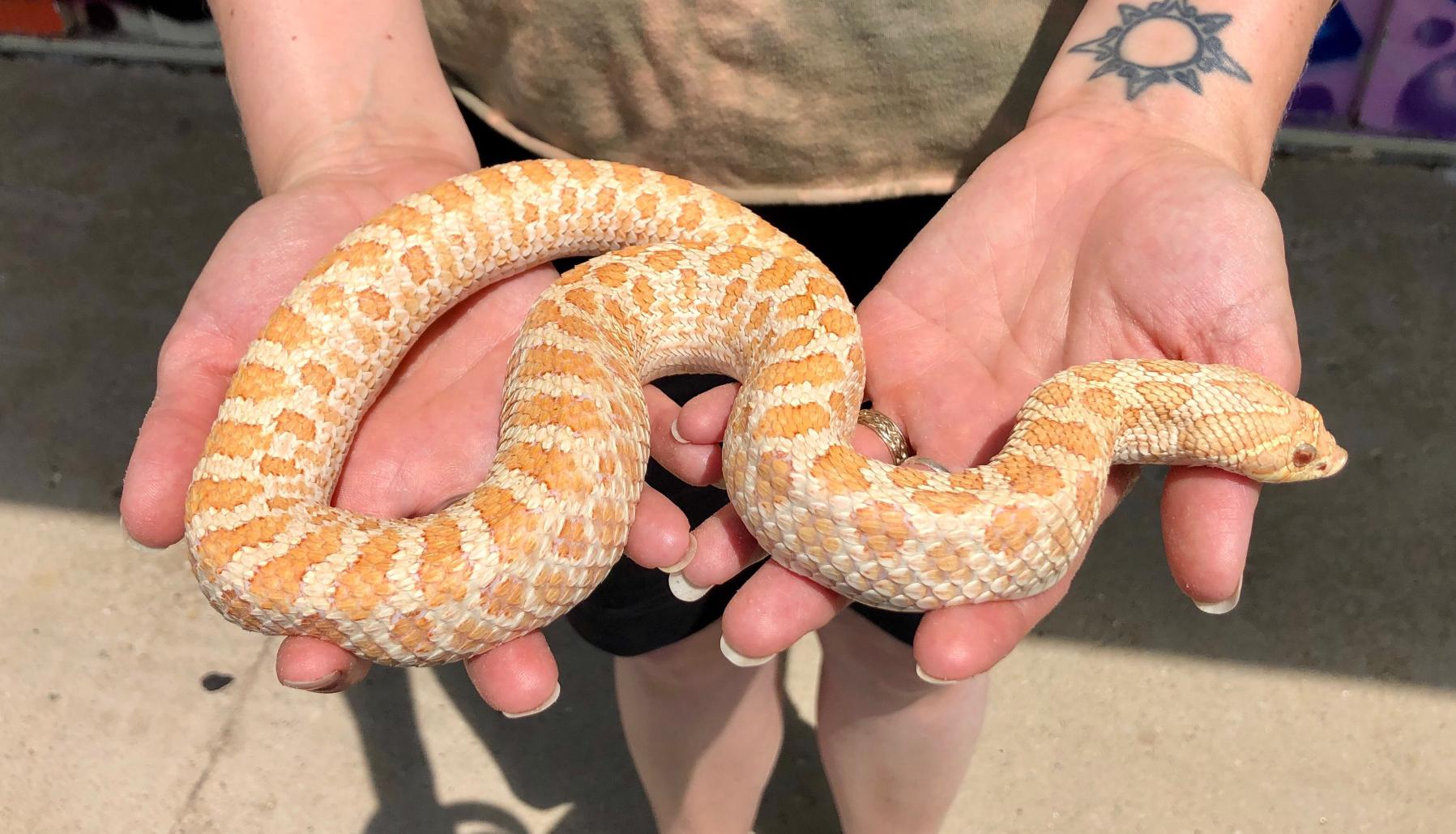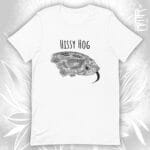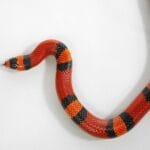Albino hognose snakes, captivating with their lack of melanin, showcase a striking palette of white, yellow, orange, or red scales and characteristic red eyes. This recessive albino mutation, naturally occurring and prized among breeders, enhances other morphs, creating a diverse array of captivating color combinations. Reaching up to 36 inches in length, these fast-growing snakes are popular pets, demanding specialized care due to their unique genetic makeup. Beyond aesthetics, understanding the genetic basis of albinism in hognose snakes unveils crucial insights into reptile pigmentation and morph development.
Decoding the Albino Mystery: Genetics and Appearance
The striking appearance of the albino hognose snake isn’t just happenstance; it’s the product of genetics. Albinism, a recessive genetic mutation, disrupts melanin production—the pigment responsible for dark coloration in animals. This results in the snake’s characteristic light hues and red eyes. For a hognose snake to be albino, it must inherit two copies of the albino gene, one from each parent. This means even if neither parent looks albino, they could still carry the gene and produce albino offspring.
5 Stunning Variations of the Albino Hognose Snake
While all albino hognose snakes share the trait of albinism, their appearance isn’t uniform. Several beautiful variations exist:
- High White: These snakes are a pristine, almost pure white, occasionally accented by the faintest hints of color.
- Orange: A warm, sunset-like orange hue defines this variation, its intensity ranging from delicate peach to vibrant tangerine.
- Yellow: Radiating warmth, these snakes showcase a vibrant yellow, reminiscent of a sunny day.
- Patterned: Some albinos retain remnants of the typical hognose pattern, creating an intriguing interplay of their light base color and shadowy markings.
- Extreme Red: The showstoppers of the albino world, these snakes boast dramatically amplified orange and red markings against a lighter backdrop, creating a fiery, jewel-like appearance.
The Albino Advantage: Creating New Morphs
The albino gene isn’t just about creating albino snakes; it’s a crucial tool for developing other morphs. When combined with other genes, it can create a dazzling array of colors and patterns. Think of it as an artist’s palette—the albino gene adds a unique element, transforming and enhancing other colors.
Top 3 Morphs Enhanced by the Albino Gene
- Snow: Combining albino with the “snow” gene results in a snake as white as freshly fallen snow.
- Extreme Red: The albino gene intensifies red tones in other morphs, creating a richer, more vibrant red.
- Sunglow: Albino contributes to the radiant yellow-orange hues of Sunglow morphs, giving them a sun-kissed appearance.
Essential Care for Your Albino Hognose Snake
Albino hognose snakes, due to their sensitivity to light and other environmental factors, require specialized care. Here’s what you need to know:
7 Essential Tips for Albino Hognose Snake Care
- Lighting: Avoid direct sunlight. Provide soft, indirect lighting with shaded areas to prevent skin and eye damage. UVB lighting, though debated, may be beneficial for vitamin D3 synthesis. Some experts suggest a low-output UVB bulb for a few hours a day.
- Temperature: Maintain a thermal gradient with a basking spot of 85-90°F and a cooler side of 70-75°F. Use a thermometer to monitor temperatures accurately.
- Humidity: Provide a humidity range of 40-70%, with a humid hide (a designated area with higher humidity) to aid shedding. Monitor humidity with a hygrometer.
- Diet: Feed appropriately sized, pre-killed frozen rodents. Avoid live prey, which can injure your snake.
- Enclosure: A 20-gallon long tank is the minimum size for an adult. Larger is always better, particularly for females, which grow larger than males. Provide a deep substrate, like aspen shavings or coconut fiber, for burrowing.
- Water: Offer fresh water in a shallow dish that the snake can easily access and soak in.
- Handling: While generally docile, hognose snakes have unique defensive displays like hissing, flattening their necks (hooding), or playing dead. Handle them gently and avoid stressing them.
Predicting Albino Offspring: Understanding the Odds
Breeding albino hognose snakes requires a grasp of genetics. Since albinism is recessive, both parents must carry the gene for albino offspring. Punnett squares are useful tools for visualizing potential outcomes:
| Parent 1 | Parent 2 | Albino Offspring Probability |
|---|---|---|
| Albino | Albino | 100% |
| Albino | Heterozygous (Carrier) | 50% |
| Heterozygous | Heterozygous | 25% |
| Heterozygous | Non-Carrier | 0% |
This table illustrates probabilities, but other genetic factors can influence results. Consult experienced breeders for guidance.
Ethical Considerations: Breeding Responsibly
The allure of albino hognose snakes and other morphs fuels breeding, raising ethical considerations. Prioritize the snakes’ health and well-being over aesthetics. Avoid inbreeding, which can lead to genetic health issues. Support reputable breeders who prioritize genetic diversity and responsible practices.
Hognose Snake Size and Venom: Addressing Common Concerns
How Big Do Albino Hognose Snakes Get?
Albino hognose snakes, like their normally pigmented counterparts, vary in size, with females generally larger than males. Males typically reach 14-24 inches, while females can reach an impressive 20-36 inches. Factors influencing their growth include genetics, diet, enclosure size, and their overall environment.
How Poisonous is a Hognose Snake?
Hognose snakes are venomous (not poisonous), producing venom in their Duvernoy’s glands primarily to subdue amphibian prey. However, they have rear fangs, requiring them to “chew” to inject venom, making envenomation of humans inefficient and generally less dangerous. Bites may cause localized reactions, like swelling and itching, often compared to a bee sting. Medical attention is always recommended after a bite. Hognose snakes prioritize dramatic defensive displays over biting. They might hiss, hood, or even play dead to deter threats.
Is a Hognose Snake a Good Pet?
Hognose snakes’ docile nature, manageable size, and stunning variations make them appealing pets, particularly for beginners. However, their unique needs and quirks require careful consideration.
| Feature | Description |
|---|---|
| Temperament | Generally docile, dramatic defensive displays |
| Size | 1.5 – 3.5 feet (adults) |
| Lifespan | 15-18 years |
| Diet | Pre-killed frozen rodents |
| Housing | 20+ gallon tank, deep substrate |
| Temperature | 85-90°F basking, 70-75°F cool side |
| Humidity | 40-70% |
| UVB Lighting | Potentially beneficial, though debated |
Their dramatic bluffs, unique care requirements, and 15-18 year lifespan demand responsible, long-term commitment. Thorough research is essential before bringing a hognose snake home.
Conclusion: The Allure of the Albino Hognose
The albino hognose snake, with its captivating colors and unique characteristics, stands out in the reptile world. By understanding their genetics, specific care needs, and the ethical considerations of breeding, we can both appreciate and contribute to their well-being. Ongoing research continually expands our understanding of these fascinating creatures, and responsible ownership ensures their continued thriving in captivity.
Uncover the truth about whether camel spiders are poisonous and delve into the fascinating world of fungi to learn if mushrooms are decomposers.
- Georgia Platform: A Southern Strategy, 1850s - March 31, 2025
- How many weeks is 40 days: Quick Conversion Guide for Accurate Results - March 31, 2025
- How many feet is 300 meters? 984 Feet: Understand Length Conversions Easily - March 31, 2025
















